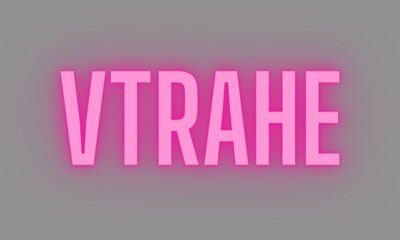Education
Designing Effective Learning Environments: The Importance of Specialized Degrees

Creating effective learning environments is crucial for academic success and holistic development. The design and structure of these spaces can significantly influence student engagement, creativity, and motivation.
In today’s education landscape, where personalized learning is gaining importance, having specialized knowledge about creating such environments is essential. Whether you are an educator, administrator, or curriculum designer, understanding the elements that drive learning effectiveness can make a profound impact.
This is where specialized degrees come in. They provide the skills and expertise needed to craft learning environments that cater to diverse student needs while promoting active participation and innovation.
The Role of Pursuing Higher Education in Designing Learning Environments
Pursuing higher education plays a pivotal role in acquiring the knowledge and skills required for designing effective learning environments. As education evolves, so do the approaches and strategies needed to meet the demands of today’s learners.
Higher education offers in-depth training on understanding diverse learning styles, integrating technology, and fostering inclusivity in classrooms. Programs tailored to educational design delve into the psychology of learning, the latest instructional technologies, and data-driven approaches that can be employed to optimize student outcomes.
One of the core benefits of specialized degrees is that they provide professionals with a comprehensive understanding of both theoretical frameworks and practical applications. This balanced approach is vital for creating environments that adapt to the needs of different learners, including those with special needs, diverse cultural backgrounds, and varying academic abilities.
Additionally, these programs often emphasize the importance of collaboration and communication within the educational ecosystem, encouraging the sharing of ideas and innovative practices.
Moreover, specialized programs such as online MSED programs offer the flexibility to acquire this essential knowledge while balancing other commitments. This allows educators and administrators to enhance their skill sets without sacrificing their current roles.
Other popular degrees you could also consider are as follows;
- Master of Science in Education with a concentration in Curriculum and Instruction Online
- Master of Science in Education with a concentration in Educational Leadership and Administration Online
- Graduate Certificate for Teacher License Addition in Exceptional Needs Online
- Post-Master’s Certificate in Educational Leadership and Administration Online
By equipping professionals with the tools to design effective learning environments, these programs help make sure that students are placed in settings where they can thrive academically and personally.
The Impact of Classroom Design on Student Engagement
Classroom Design goes beyond simply arranging desks and chairs; it’s about cultivating an environment that. Studies have shown that factors such as lighting, color schemes, furniture arrangement, and access to resources can directly affect a student’s ability to focus, participate, and retain information.
Classrooms that are designed with flexibility in mind—allowing for both independent study and group collaboration—enable students to engage more fully in their learning activities.
A key element in effective classroom design is ensuring that the space supports different learning modalities. For instance, some students may excel in hands-on, project-based activities, while others might benefit from quiet reading corners or technology-equipped stations.
Understanding these needs and designing spaces that can be easily adjusted to suit various learning activities is critical for student engagement.
In addition, incorporating technology in the classroom is no longer optional. Interactive whiteboards, digital learning platforms, and adaptive learning technologies are essential tools that modern educators must integrate into their classroom designs.
This technological inclusion allows for personalized learning experiences, making sure that each student receives the support they need to succeed. Specialized degrees provide the training necessary to effectively incorporate these tools into learning environments while maintaining a balance between traditional and innovative approaches.
The Role of Technology in Modern Learning Environments
In the 21st century, technology is at the heart of effective learning environments. From interactive tools to virtual classrooms, technology has transformed how students learn and interact with educational content.
Designing spaces that accommodate these technological advancements is essential for creating a seamless learning experience.
One of the significant shifts in education has been the move toward blended learning environments, where digital resources complement traditional instruction. This approach increases access to information and also provides students with a more personalized learning journey.
For example, adaptive learning systems can analyze a student’s progress and adjust content accordingly, making sure that the learning experience is tailored to their needs.
Furthermore, the integration of virtual reality (VR) and augmented reality (AR) is opening new doors for experiential learning. These tools allow students to immerse themselves in virtual environments that simulate real-world scenarios, making complex concepts easier to grasp.
Educators who are well-versed in these technologies can design learning environments that make the most of these resources, creating more engaging and effective educational experiences.
Specialized degrees focused on educational technology and design equip professionals with the knowledge to integrate these tools effectively. They learn how to select the right technologies, design digital learning experiences, and manage the technical aspects of modern classrooms.
By pursuing such a degree, educators are better prepared to navigate the complexities of today’s tech-driven education landscape.
Creating Inclusive Learning Spaces
Inclusion is a fundamental principle in designing learning environments today. Students come from diverse backgrounds with varying levels of ability, cultural perspectives, and educational needs. A well-designed learning environment considers these factors and creates spaces where every student feels valued and supported.
Inclusive classrooms involve more than just physical accessibility. They require thoughtful consideration of sensory elements, social dynamics, and instructional approaches that cater to all learners. For example, using flexible seating arrangements can help students with attention challenges feel more comfortable while providing quiet zones can benefit those who need a calm space to concentrate.
Color choices, noise levels, and even the positioning of resources can impact a student’s learning experience.
Another aspect of inclusivity is ensuring that learning materials and activities reflect diverse cultures and perspectives. This helps students see themselves represented in their learning, fostering a sense of belonging. Educators who specialize in designing inclusive environments are trained to recognize the subtle barriers that may exist and work to remove them, creating an atmosphere where every student has an opportunity to succeed.
Specialized degrees offer training in designing inclusive learning spaces by covering topics like differentiated instruction, culturally responsive teaching, and universal design for learning (UDL).
Measuring the Success of Learning Environments
An effective learning environment is one that consistently meets the needs of its students. However, measuring the success of these environments requires more than just observing academic performance.
It involves evaluating student engagement, well-being, and overall satisfaction within the space. Data-driven insights are essential for making informed decisions about improvements and adjustments.
Educators and administrators who are trained in assessing learning environments are equipped to use a variety of metrics, including student feedback, behavioral observations, and academic data. By analyzing these factors, they can identify areas that need improvement and implement strategies to enhance the learning experience.
Specialized degrees often include coursework on assessment techniques and data analysis, giving professionals the skills they need to measure the effectiveness of their designs and make continuous improvements.
Moreover, maintaining an open line of communication with students is crucial for understanding their needs and preferences. Surveys, focus groups, and one-on-one discussions can provide valuable insights into what works and what doesn’t in a learning environment.
By incorporating student input, educators can design spaces that are more aligned with their learners’ needs and preferences.
All in all, the design of effective learning environments is a multifaceted process that requires specialized knowledge and skills. From understanding the role of higher education to integrating technology and fostering inclusivity, each element plays a vital role in creating spaces where students can thrive.
Education
Understanding the “Current Influencer” NYT Crossword Clue

Crossword puzzles have long intrigued minds, but none quite like those in the New York Times. With clever wording and layered meanings, the clues often lead solvers into delightful confusion. One such clue that’s generated buzz recently is: “Current Influencer”. In the context of the NYT Crossword, what does this really mean? Current Influencer” NYT Crossword
Whether you’re a seasoned crossword enthusiast or someone who stumbled upon the clue during a casual attempt at puzzle-solving, this article aims to demystify the clue “Current Influencer” through detailed explanation, relevant associations, and the crossword logic behind its structure.
The Culture of Cryptic Clues in NYT Crosswords
The New York Times crossword puzzles are known for their wit, subtlety, and layered language. Unlike direct puzzles where the answer matches the clue explicitly, many NYT clues use:
Wordplay
Puns
Cultural references
Abbreviations and acronyms
Homonyms
“Current Influencer” fits perfectly into this mold. It seems straightforward but actually operates on a deeper, metaphorical level.
Breaking Down the Clue “Current Influencer”
At first glance, “current influencer” might bring to mind a modern-day social media personality — someone trending on TikTok or Instagram. However, this literal interpretation often leads solvers astray in the NYT puzzle world.
Instead, it’s crucial to dissect both terms in multiple contexts:
Current: Could refer to time (present), electricity (electrical current), water flow (ocean/river current), or even trends.
Influencer: Might imply a person who affects others, or more abstractly, something that causes a shift or movement.
Together, the phrase could point toward something influencing a current or being influenced by current.
Common Answers for “Current Influencer” in Crossword Context
Let’s dive into plausible answers the NYT Crossword might use based on past patterns and solving databases:
AMP: Short for ampere, a unit of electric current — this plays into the pun on “current” (electricity) and “influencer” (something that causes flow).
ELNINO: A weather system known for influencing ocean currents globally.
ION: Electrically charged particle, literally influencing electric current.
TIDE: A natural influencer of ocean currents.
The brilliance of the clue is how the answer hinges on interpreting “current” beyond the modern slang and understanding “influencer” as a causal agent, not necessarily a person.
Why Wordplay Is Crucial to NYT Crossword Solvers
To truly appreciate clues like “Current Influencer,” understanding how constructors play with language is essential. Wordplay is a critical element in NYT crossword construction. Clues are often:
Figurative, not literal
Minimalist in language
Sometimes misleading by design
This turns the crossword into more than a vocabulary test — it becomes a riddle where lateral thinking reigns supreme.
The Rise of Meta Clues and Modern Vocabulary
Over the years, crossword clues have evolved to reflect modern vocabulary. Words like “meme,” “hashtag,” and even “TikTok star” have entered the puzzle lexicon. This evolution means solvers have to stay updated with both traditional knowledge and pop culture.
However, in cases like “Current Influencer,” the clue disguises itself as modern while requiring old-school interpretation. That’s the NYT puzzle’s genius.
Common Solver Mistakes with the “Current Influencer” Clue
Let’s explore where solvers go wrong when facing this clue:
Taking it too literally: Jumping straight to “TikToker” or “YouTuber” ignores the wordplay.
Missing dual meanings: Overlooking “current” as a scientific term.
Overthinking: Searching for complex answers when simple ones like “ION” or “AMP” are more likely.
Understanding this helps you develop the right mindset for future puzzle solving.
The Role of Context in Crossword Solving
One of the key strategies for solving cryptic clues like “Current Influencer” is using surrounding answers. The intersecting words can narrow down possible answers significantly. Here’s how:
Check how many letters the clue demands.
Use existing letters to guess plausible words.
Match definitions based on known word lengths.
Crossword puzzles are rarely about one clue — they’re about how clues connect.
Crossword Culture: How Clues Like This Reflect Broader Trends
The inclusion of clues like “Current Influencer” shows the evolving nature of puzzles. Once limited to Shakespeare and geography, they now span:
Pop culture
Technology
Environmental science
Internet slang
This helps keep the puzzles fresh and engaging across generations.
How to Improve at Solving Clues Like “Current Influencer”
If you’re intrigued by clues like this, here are some tips to get better:
Practice Daily: The more puzzles you solve, the more patterns you recognize.
Expand Your Vocabulary: Read across genres—science, literature, tech, news.
Use Crossword Apps: Tools like CrossBoss or Wordplay offer great practice.
Join Online Forums: Communities like r/crossword on Reddit often explain tricky clues.
Building your crossword IQ is a journey—embrace it one clue at a time.
The Legacy of Clue Craftsmanship in NYT Puzzles
Behind every NYT crossword is a team of expert constructors and editors. Their craftsmanship is what creates delightful moments like the realization that “Current Influencer” could be “ION.”
Every clue goes through testing, editing, and revision to ensure fairness and balance across difficulty levels. The result is a puzzle that challenges your logic, language, and lateral thinking.
How “Current Influencer” Became a Popular NYT Clue
Part of why this clue gained attention is because it trended on puzzle-solving forums and social media. People enjoy:
Sharing their “aha!” moment
Debating alternate answers
Admiring the cleverness of the clue’s dual meaning
It’s these shared moments of discovery that make crossword culture so rich and enduring.
Why “Current Influencer” Resonates with Modern Solvers
We live in a time dominated by influencers—social, political, digital. But when the NYT flips the script and uses “influencer” in an electrical or oceanographic sense, it engages solvers in a way that’s both humorous and intellectually satisfying.
It’s a reminder that language is constantly shifting and full of surprises.
How NYT Crossword Encourages Creative Thinking
Clues like “Current Influencer” push boundaries. They reward creative problem-solving, curiosity, and resilience. Solving them is about more than just vocabulary—it’s about approaching a problem from many angles.
That’s why the NYT Crossword has maintained cultural relevance for decades.
Conclusion
The clue Current Influencer” NYT Crossword exemplifies everything that makes the puzzle great—subtlety, dual meaning, and intellectual play. While the surface might suggest a trending personality, the deeper solution lies in understanding how current, as a concept, can be influenced in many forms—electrical, environmental, or metaphorical.
This clue captures the heart of what makes NYT puzzles so rewarding: their ability to surprise, educate, and entertain all at once. Whether the answer is “ION,” “AMP,” or something equally clever, the real joy lies in the journey of discovery.
ALSO READ:Exploring the Core Aspects of www.disquantified.org
Frequently Asked Questions
What does “Current Influencer” mean in the NYT Crossword?
It’s a clue that uses wordplay—often referring to something that affects current, like an ION, AMP, or ELNINO. Current Influencer” NYT Crossword
Is “Current Influencer” a modern clue or an old reference?
It’s a modern clue with a clever twist, using contemporary language but pointing to traditional science or natural phenomena.
Why do NYT Crossword clues have double meanings?
To challenge solvers and make the puzzle more engaging. It’s a blend of humor, intellect, and wordplay.
Are all “influencer” clues about social media?
Not always. As seen with this clue, “influencer” can mean anything that causes change or movement.
What’s the best way to solve ambiguous clues like this?
Check the context, look for puns or scientific meanings, and use cross-letters to guide your answer.
Let me know if you’d like this formatted for your website, turned into a downloadable PDF, or styled with a visual layout!
Education
Boosting Sales in the Educational Sector With Bulk Journals

The educational sector is a hotspot for many businesses that sell school-related products. This includes stationery tools like paper, pens, and journals. Students, especially, love customized stationery. Not only that, but schools also often require standardized journals to be distributed to students. This is why the educational sector offers immense potential for businesses selling customized journals.
By understanding the buying cycles of educational organizations and offering competitive pricing, businesses can tap into bulk journals with the academic sector to make a proper profit.
Why Target Educational Institutions?
Schools and colleges have ongoing needs for journals, planners, and notebooks. These tools are essential for student organization, academic planning, and teacher lesson preparations. Custom bulk journals tailored to the academic year’s structure or student preferences are in high demand.
Targeting schools ensures steady bulk orders and helps businesses establish long-term relationships with institutions. A reliable supplier becomes a go-to partner for yearly procurement needs.
Understanding Academic Buying Cycles
Educational institutions often operate on strict schedules for purchases. The academic buying cycle typically aligns with school terms and fiscal budgets. Key periods include:
- Summer and Early Fall: Schools prepare for the new academic year and order student supplies.
- End of the Year: Teachers and administrators stock up for the next term or purchase gifts for staff appreciation.
Businesses targeting this sector should plan marketing efforts and promotions to align with these cycles. Advanced planning also allows institutions to budget for larger purchases.
Bulk Pricing Structures for Schools
Educational institutions are budget-conscious and prefer suppliers offering bulk discounts. Competitive pricing structures can set businesses apart. Key considerations include:
- Tiered Discounts: Offering discounts based on the quantity purchased ensures schools save more when ordering larger orders.
- Customized Options at Lower Costs: Providing customization at reduced rates for bulk orders increases appeal.
- Subscription Models: Some schools benefit from annual contracts, guaranteeing recurring business for the supplier.
Being transparent about pricing and offering flexible payment terms can help build trust with school administrators.
Specialized Academic Planners and Student Journals
Tailoring products to the needs of schools can significantly boost sales. Two popular products for educational institutions include:
- Academic Planners: Designed for students and teachers, these planners include class schedules, assignment trackers, and school calendar pages. Businesses can customize them with the institution’s name, logo, and colors.
- Student Journals: Durable journals suited for daily use are students’ staples. Customizable covers and inspirational designs make them appealing to learners.
Adding features like pre-printed timetables or motivational quotes can enhance the value of these products.
Tips for Selling Bulk Journals to Educational Institutions
- Highlight Durability: Ensure journals are designed to withstand daily student use.
- Offer Samples: Free samples allow schools to assess quality before committing to a large order.
- Emphasize Customization: Schools appreciate journals tailored to their branding and academic needs.
- Be Accessible: Establish dedicated communication channels to handle queries from busy school administrators.
Key Takeaways
Selling bulk journals to educational institutions requires understanding their unique needs, academic cycles, and budget constraints. Businesses that offer tailored academic planners, competitive pricing, and high-quality products can build lasting relationships with schools. By aligning with educational priorities, suppliers can secure consistent orders and establish themselves as reliable partners in the academic world.
Education
The Benefits of Completing Court-Ordered Courses Online: Convenience and Compliance

Introduction
In today’s digital age, fulfilling court-mandated educational requirements has never been more accessible. Online courses designed for court orders offer a streamlined way for individuals to accomplish their legal obligations while accommodating their busy lives. This format not only promotes efficiency but also ensures compliance with court mandates. With the rise of digital education platforms, individuals can now complete court-ordered classes without the logistical challenges that traditional classroom settings might pose.
Convenience of Online Learning
One of the most significant advantages of completing court ordered classes online is the unparalleled convenience it offers. Whether you must take a course on anger management, substance abuse, or any other mandated topic, online platforms provide a user-friendly interface that can be accessed anytime, anywhere. This eliminates the need to commute to a physical location, saves time, and reduces the stress associated with travel.
The digital approach allows participants to integrate learning into their daily routines, ensuring they meet their legal requirements without causing significant disruptions to work or family commitments. This convenience is a key factor in promoting adherence to court orders, as individuals are likelier to engage with a program that fits seamlessly into their lifestyle.
Flexibility and Accessibility
Flexibility is another hallmark of completing court-ordered courses online. With 24/7 availability, these courses empower learners to choose when and where they study. This adaptability is especially beneficial for those with varying work schedules, caregiving responsibilities, or other personal commitments that make attending traditional classes challenging.
Online courses also cater to different learning preferences. Interactive modules, videos, and quizzes allow individuals to absorb material in ways that resonate best with them. This variety can enhance comprehension and retention, ensuring participants meet legal requirements and gain valuable insights and skills.
Ensuring Timely Compliance
Meeting deadlines is crucial when it comes to court-ordered education. Online courses are structured to support timely compliance, often including automated reminders and progress-tracking features that help participants stay on schedule. These tools add a layer of accountability, ensuring that individuals can continuously monitor their advancement through the course.
Additionally, online platforms often provide immediate access to completion certificates once the course is finished. This prompt delivery alleviates concerns about documentation, allowing individuals to present proof of compliance to the court without delay. As a result, participants can fulfill their legal obligations with confidence and peace of mind.
Structured Curriculum and Support
While flexibility is a significant advantage of online courses, their structured curriculum ensures that all relevant material is comprehensively covered. These courses are meticulously designed to address the court’s specific requirements, providing a transparent roadmap for participants to follow.
Moreover, online courses frequently include access to support resources, such as knowledge bases and customer service representatives, who can assist with technical issues or questions about the course content. This support network can help participants navigate any challenges, further facilitating the completion of their court-ordered programs.
Privacy and Confidentiality
Privacy is a significant consideration for individuals enrolled in court-ordered courses. Online learning platforms typically offer a layer of confidentiality that traditional classrooms may not. Participants can work through sensitive material in the comfort and privacy of their own homes without the potential stigma of attending in-person classes.
This private environment allows individuals to engage more openly with course content, fostering a more thorough understanding of the material and encouraging personal growth. Furthermore, online platforms often adhere to strict data protection policies, ensuring that personal information remains secure throughout the course.
Conclusion
In summary, completing court-ordered courses online presents several compelling advantages that make compliance both convenient and feasible. The flexibility, accessibility, and structured support that online platforms offer ensure that individuals can meet their legal obligations efficiently and with ease. As more people turn to digital solutions for their educational needs, online court-ordered courses continue to prove themselves as a reliable and effective means of achieving compliance while fostering personal development.

 Cartoon1 year ago
Cartoon1 year agoUnlocking the Potential of Nekopoi.care: A Comprehensive Guide

 Game1 year ago
Game1 year agoExploring Aopickleballthietke.com: Your Ultimate Pickleball Destination

 BUSINESS1 year ago
BUSINESS1 year agoWhat Companies Are In The Consumer Services Field

 BUSINESS12 months ago
BUSINESS12 months agoUnraveling the Mystery of 405 Howard Street San Francisco charge on Credit Card

 HOME IMPROVEMENT1 year ago
HOME IMPROVEMENT1 year agoVtrahe vs. Other Platforms: Which One Reigns Supreme?

 TECHNOLOGY12 months ago
TECHNOLOGY12 months agoThe Guide to Using Anon Vault for Secure Data Storage

 ENTERTAINMENT8 months ago
ENTERTAINMENT8 months agoUnderstanding Bunkr Album: A Comprehensive Guide

 ENTERTAINMENT1 year ago
ENTERTAINMENT1 year agoThe Epic Return: Revenge of the Iron-Blooded Sword Hound
















